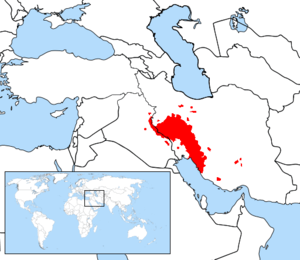Luri language
| Luri | |
|---|---|
| لوری | |
| Native to | Iran, Iraq, Kuwait, UAE, Oman |
| Region | Southern Zagros (mainly in the Loristan province.) |
| Ethnicity | Lurs |
Native speakers | 3½ million (1999–2001)[1] |
|
Indo-European
| |
| Language codes | |
| ISO 639-3 |
Variously: lrc – Northern Luri bqi – Bakhtiari luz – Southern Luri zum – Kumzari |
 | |
Luri (Persian: لری [loriː], [luriː]) is a Southwestern Iranian language[2][3] spoken mainly by the Lur and Bakhtiari peoples of the Iranian provinces of Lorestan, Chaharmahal and Bakhtiari, Fars province (especially Lamerd), Khuzestan, Esfahan province and Kohgiluyeh and Boyer-Ahmad. Lori is a descendant of a variant of Middle Persian[4] and is lexically similar to modern Persian.[4]

According to the linguist Don Stilo: "Persian, Lori-Baḵtiāri and others, are derived directly from Old Persian through Middle Persian/Pahlavi".[5] These dialects are also referred to as the “Persid” southern Zagros group.[6]

The special character of the Lori language suggests that its spreading area was Iranicized from Persia and not from Media.[7][8]
Lori also represents a language continuum between Persian language and Kurdish language varieties, and is itself composed of three distinct languages: Loristani, Bakhtiari and Southern Lori.[4] According to John Limbert, "Luri and Bakhtiari are much more closely related to Persian, than Kurdish."[9]Traditionally, Lori has been categorised as a single language. Some scholars have stated that Lori is only a highly accented or لهجه (lahjeh) form of Persian. On the other hand, some researchers are supporting the division of the Lori continuum into more than one language.[4]
According to Encyclopædia Iranica, "All Lori dialects closely resemble standard Persian and probably developed from a stage of Persian similar to that represented in Early New Persian texts written in Perso-Arabic script. The sole typical Lori feature not known in early New Persian or derivable from it is the inchoative marker (see below), though even this is found in Judeo-Persian texts".[2] There do exist transitional dialects between Southern Kurdish and Lori-Bakhtiāri, and Lori-Bakhtiāri itself may be called a transitional idiom between Kurdish and Persian.[10] "According to Sharaf Khan Bidlisi a sixteenth century historian, in his history book Sharafnama" Lurs are one of the four Kurdish tribe..[11] However Vladimir Minorsky comments on this [12] that the Lur and Guran stand apart from Kurdish in the modern sense for both linguistic and ethnological reasons.
See also
References
- ↑ Northern Luri reference at Ethnologue (17th ed., 2013)
Bakhtiari reference at Ethnologue (17th ed., 2013)
Southern Luri reference at Ethnologue (17th ed., 2013)
Kumzari reference at Ethnologue (17th ed., 2013) - ↑ 2.0 2.1 http://www.iranicaonline.org/articles/lori-dialects
- ↑ Lecoq P. Les dialectes du sud-ouest de l'Iran // Compendium Linguarum Iranicarum. Wiesbaden, 1989.
- ↑ 4.0 4.1 4.2 4.3 Erik John Anonby, "Update on Luri: How many languages?" // Journal of the Royal Asiatic Society (Third Series), Volume 13, Issue 02, Jul 2003, pp 171–197
- ↑ Don Stillo, "Isfahan-Provincial Dialetcs" in Encyclopedia Iranica, Excerpt: "While the modern SWI languages, for instance, Persian, Lori-Baḵtiāri and others, are derived directly from Old Persian through Middle Persian/Pahlavi"
- ↑ Bakhtiari tribe and the Bakhtiari dialect, Encyclopedia Iranica
- ↑ Yar-Shater, Ehsan. 1982. Encyclopaedia Iranica. London: Routledge & Kegan Paul. V, p. 617a
- ↑ Houtsma, M. T., 1987. E.J. Brill's First Encyclopaedia of Islam, 1913–1936. Published by BRILL. Lur. p. 41. (and p. 281) ISBN 90-04-08265-4, ISBN 978-90-04-08265-6
- ↑ Limbert, John: Journal of Iranian Studies Vol. 1, No. 2 at p. 47 (1968) , "The Origin and Appearance of Kurds in Pre-Islamic Iran".
- ↑ kurdish language, Encyclopedia Iranica
- ↑ Sharaf Khan Bidlisi
- ↑ V. Minorsky, "The Guran" , BSOAS, University of London, Vol. 11, No. 1 (1943 pp 75-103) comments on Sharafkhans statement: "This enumeration gives a clear idea of the main groups of the Iranian mountaineers, but only the Kurmanj, and possibly the Kalhur, come under the heading Kurd, whereas the Lur and the Guran stand apart, both for linguistic and ethnological reasons"
External links
| Luri language test of Wikipedia at Wikimedia Incubator |
- Lor in the World Atlas of Language Structures Online
- The Universal Declaration of Human Rights in Lor
- Bakhtiari tribe and the Bakhtiari dialect, Iranica
- Lurish geographical in middle east
- Lurish Language : Hown many languages? - by Erik john anonby - The royal asiatic society 2003 - Printed in UK
| |||||||||||||||||||||||||||||||||||||||||||||||||||||||||||||||||||||||||||||||||||||||||||||||||||||||||||||||||||||||||||||||||||||||||||||||||||||||||||||